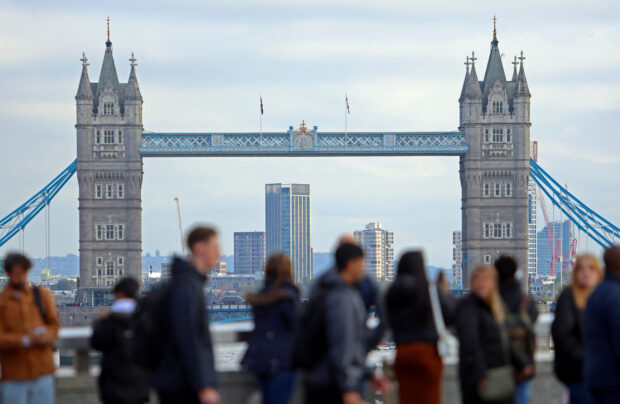
People walk over London Bridge looking at a view of Tower Bridge in the City of London financial district in London, Britain, Oct 25, 2023. REUTERS/ Susannah Ireland/File photo
LONDON -British pay grew at the weakest pace in more than a year at the end of 2023 but the labor market slowdown was probably not significant enough to spur the Bank of England into quicker action towards cutting interest rates.
Sterling strengthened against the U.S. dollar and the euro and investors scaled back their bets on BoE rate cuts in 2024 after the Office for National Statistics published its data.
Wages excluding bonuses grew by 6.2 percent in the last three months of 2023 compared with the same period a year earlier.
That was down from 6.7 percent in the three months to November and represented the slowest increase since the three months to October 2022, but exceeded a median forecast of 6 percent in a Reuters poll of analysts.
Britain’s economy may have fallen into a shallow recession in the second half of 2023, something official data is expected to confirm on Thursday, but the labor market remains tight as businesses struggle to find and retain staff. High levels of long-term sickness are also hampering employers.
Labor market
Including bonuses, which can be volatile, pay growth slowed to 5.8 percent from 6.7 percent in the three months to November, the smallest increase since the three months to July 2022 but above the Reuters poll forecast of 5.6 percent.
Jake Finney, an economist at PwC UK, said the latest fall in vacancies showed that the heat was coming out of the labor market and pay growth was continuing to slow.
Vacancies fell for the 19th time in a row in the three months to January, dropping by 26,000 from the August-to-October period but were only 2,000 lower than in the three months to December.
“The lingering concern for the Bank of England will be that the labor market has not cooled sufficiently to achieve a sustainable return to the 2 percent inflation target,” Finney said.
The BoE is watching pay growth closely as it tries to gauge how much inflation pressure remains in the economy and whether it can start to consider cutting interest rates from their highest level since 2008.
Regular pay in the private sector rose by an annual 6.2 percent in the fourth quarter, stronger than the BoE’s forecast of 6 percent that it published earlier this month.
The BoE is worried that pay might continue to rise too quickly for inflation to fall to its 2 percent target.
More evidence required for BOI
“With today’s print pointing to some signs of slowing in a still strong labor market, significantly more evidence of cooling is likely required before the Bank is ready to consider cutting rates,” Hugh Gimber, global market strategist at J.P. Morgan Asset Management, said.
Tuesday’s data showed the jobless rate fell to 3.8 percent between October and December and employment rose by 72,000 people.
The ONS has reweighted those data sets to account for changes in population estimates, but a full overhaul of its Labor Force Survey will only take place in September.
There have been other signs that Britain’s jobs market is gradually coming off the boil.
Employers plan the first drop in nearly four years in the pace of pay rises over the coming 12 months, a survey showed on Monday, echoing a similar set of data last week.
Workers saw the biggest increase in their regular earnings adjusted for consumer price inflation since the three months to September 2021, with a rise of 1.9 percent on an annual basis.
However, British households are on course to suffer a first decline in living standards over the course of a parliament since World War Two, a tough backdrop for Prime Minister Rishi Sunak who is expected to call a national election in late 2024.